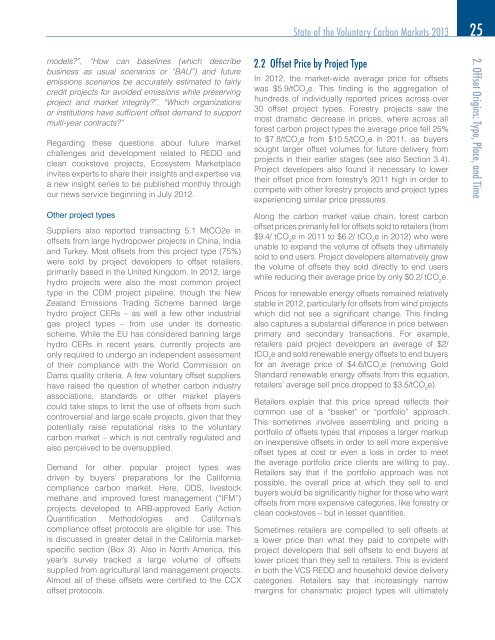Maneuvering the Mosaic: Full Report - Forest Trends
Maneuvering the Mosaic: Full Report - Forest Trends
Maneuvering the Mosaic: Full Report - Forest Trends
You also want an ePaper? Increase the reach of your titles
YUMPU automatically turns print PDFs into web optimized ePapers that Google loves.
models?”, “How can baselines (which describe<br />
business as usual scenarios or “BAU”) and future<br />
emissions scenarios be accurately estimated to fairly<br />
credit projects for avoided emissions while preserving<br />
project and market integrity?”, “Which organizations<br />
or institutions have suffi cient offset demand to support<br />
multi-year contracts?”<br />
Regarding <strong>the</strong>se questions about future market<br />
challenges and development related to REDD and<br />
clean cookstove projects, Ecosystem Marketplace<br />
invites experts to share <strong>the</strong>ir insights and expertise via<br />
a new insight series to be published monthly through<br />
our news service beginning in July 2012.<br />
O<strong>the</strong>r project types<br />
Suppliers also reported transacting 5.1 MtCO2e in<br />
offsets from large hydropower projects in China, India<br />
and Turkey. Most offsets from this project type (75%)<br />
were sold by project developers to offset retailers,<br />
primarily based in <strong>the</strong> United Kingdom. In 2012, large<br />
hydro projects were also <strong>the</strong> most common project<br />
type in <strong>the</strong> CDM project pipeline, though <strong>the</strong> New<br />
Zealand Emissions Trading Scheme banned large<br />
hydro project CERs – as well a few o<strong>the</strong>r industrial<br />
gas project types – from use under its domestic<br />
scheme. While <strong>the</strong> EU has considered banning large<br />
hydro CERs in recent years, currently projects are<br />
only required to undergo an independent assessment<br />
of <strong>the</strong>ir compliance with <strong>the</strong> World Commission on<br />
Dams quality criteria. A few voluntary offset suppliers<br />
have raised <strong>the</strong> question of whe<strong>the</strong>r carbon industry<br />
associations, standards or o<strong>the</strong>r market players<br />
could take steps to limit <strong>the</strong> use of offsets from such<br />
controversial and large scale projects, given that <strong>the</strong>y<br />
potentially raise reputational risks to <strong>the</strong> voluntary<br />
carbon market – which is not centrally regulated and<br />
also perceived to be oversupplied.<br />
Demand for o<strong>the</strong>r popular project types was<br />
driven by buyers’ preparations for <strong>the</strong> California<br />
compliance carbon market. Here, ODS, livestock<br />
methane and improved forest management (“IFM”)<br />
projects developed to ARB-approved Early Action<br />
Quantifi cation Methodologies and California’s<br />
compliance offset protocols are eligible for use. This<br />
is discussed in greater detail in <strong>the</strong> California marketspecifi<br />
c section (Box 3). Also in North America, this<br />
year’s survey tracked a large volume of offsets<br />
supplied from agricultural land management projects.<br />
Almost all of <strong>the</strong>se offsets were certifi ed to <strong>the</strong> CCX<br />
offset protocols.<br />
State of <strong>the</strong> Voluntary Carbon Markets 2013 25<br />
2.2 Offset Price by Project Type<br />
In 2012, <strong>the</strong> market-wide average price for offsets<br />
was $5.9/tCO 2 e. This fi nding is <strong>the</strong> aggregation of<br />
hundreds of individually reported prices across over<br />
30 offset project types. <strong>Forest</strong>ry projects saw <strong>the</strong><br />
most dramatic decrease in prices, where across all<br />
forest carbon project types <strong>the</strong> average price fell 25%<br />
to $7.8/tCO 2 e from $10.5/tCO 2 e in 2011, as buyers<br />
sought larger offset volumes for future delivery from<br />
projects in <strong>the</strong>ir earlier stages (see also Section 3.4).<br />
Project developers also found it necessary to lower<br />
<strong>the</strong>ir offset price from forestry’s 2011 high in order to<br />
compete with o<strong>the</strong>r forestry projects and project types<br />
experiencing similar price pressures.<br />
Along <strong>the</strong> carbon market value chain, forest carbon<br />
offset prices primarily fell for offsets sold to retailers (from<br />
$9.4/ tCO 2 e in 2011 to $6.2/ tCO 2 e in 2012) who were<br />
unable to expand <strong>the</strong> volume of offsets <strong>the</strong>y ultimately<br />
sold to end users. Project developers alternatively grew<br />
<strong>the</strong> volume of offsets <strong>the</strong>y sold directly to end users<br />
while reducing <strong>the</strong>ir average price by only $0.2/ tCO 2 e.<br />
Prices for renewable energy offsets remained relatively<br />
stable in 2012, particularly for offsets from wind projects<br />
which did not see a signifi cant change. This fi nding<br />
also captures a substantial difference in price between<br />
primary and secondary transactions. For example,<br />
retailers paid project developers an average of $2/<br />
tCO 2 e and sold renewable energy offsets to end buyers<br />
for an average price of $4.6/tCO 2 e (removing Gold<br />
Standard renewable energy offsets from this equation,<br />
retailers’ average sell price dropped to $3.5/tCO 2 e).<br />
Retailers explain that this price spread refl ects <strong>the</strong>ir<br />
common use of a “basket” or “portfolio” approach.<br />
This sometimes involves assembling and pricing a<br />
portfolio of offsets types that imposes a larger markup<br />
on inexpensive offsets in order to sell more expensive<br />
offset types at cost or even a loss in order to meet<br />
<strong>the</strong> average portfolio price clients are willing to pay..<br />
Retailers say that if <strong>the</strong> portfolio approach was not<br />
possible, <strong>the</strong> overall price at which <strong>the</strong>y sell to end<br />
buyers would be signifi cantly higher for those who want<br />
offsets from more expensive categories, like forestry or<br />
clean cookstoves – but in lesser quantities.<br />
Sometimes retailers are compelled to sell offsets at<br />
a lower price than what <strong>the</strong>y paid to compete with<br />
project developers that sell offsets to end buyers at<br />
lower prices than <strong>the</strong>y sell to retailers. This is evident<br />
in both <strong>the</strong> VCS REDD and household device delivery<br />
categories. Retailers say that increasingly narrow<br />
margins for charismatic project types will ultimately<br />
2. Offset Origins: Type, Place, and Time
















